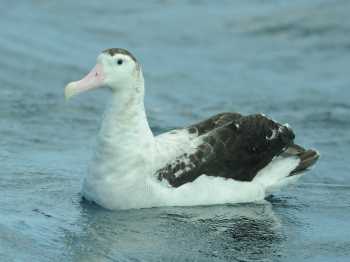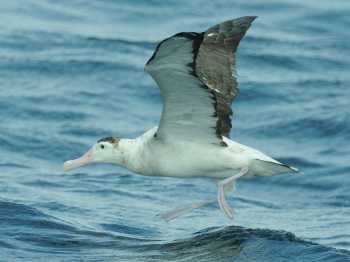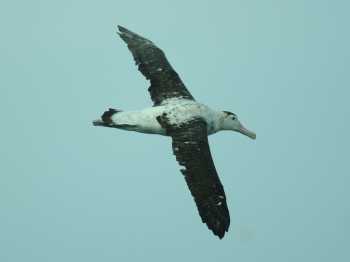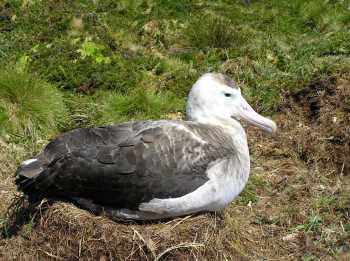A great albatross of the genus Diomedea was seen during a Zest for Birds pelagic trip on the m.v. Zest II on 18 September 2010, at a position around 34° 47.5'S, 18° 18.5'E, some 28 nm SSW of Cape Point, Western Cape, South Africa. The bird was in a large group of birds foraging in the wake of the trawler Flame Thorn, and was seen three times over a period of around 45 minutes when it was photographed both flying and resting on the sea surface.



The great albatross off Cape Point. Photographs by John Graham
The bird best fits Plumage D as illustrated (Plate 2) by Onley & Scofield (2007), which they assign to both Tristan and Antipodean D. antipodensis Albatrosses (but not to Wandering Albatrosses D. exulans). A comparison with a large suite of sexed Tristan Albatrosses photographed while incubating on Gough Island over 2007-2009 shows strong similarities in plumage to many of the females, but not to the males which tend to lack such a marked cap.

According to Lindsay Smith (Southern Oceans Seabird Study Association, Australia) an Antipodean Albatross would show some dark spots on the nail of the bill (maxillary unguis) and at least some small dark marks on the tomia (cutting edges of the bill). The mandibular unguis would also show some darker marks. These features are all absent on the Cape Point bird, leading him to believe it is a Tristan Albatross. However, Onley & Scofield (2007; pp. 125-126) state that only a "small number" of especially immature and female Antipodean Albatrosses have a dusky tip to the lower mandible and dark cutting edges to the upper mandible.
Although Tristan Albatrosses are smaller than Wandering Albatrosses (which also occur in South African waters), they are similar-sized to Antipodean Albatrosses (Cuthbert et al. 2003). In any event, judging relative size from a photograph of a single bird is highly problematic.
Tristan Albatrosses are known to reach South African waters from both recoveries of metal-banded birds and sightings of colour-banded birds (Cooper 1988, Goren & Ryan 2010) and satellite-tracked birds have approached the African Continent (to 15°E) while breeding (Cuthbert et al. 2005).
In contrast, there are no records of Antipodean Albatrosses reaching South African waters, their known at-sea distribution being restricted to Pacific waters. On the balance of probabilities, therefore, the bird photographed off South Africa is likely to be a Tristan Albatross, probably an adult female, although this cannot be stated with full certainty.
We thank Lindsay Smith and Erica Sommer for their valued comments.
References:
Cooper, J. 1988. Bird ringing at Gough Island, 1982-1987; with an analysis of movements of Wandering Albatrosses. South African Journal of Antarctic Research 18: 21-22.
Cuthbert, R.[J.], Hilton, G., Ryan, P.[G.] & Tuck, G.N. 2005. At-sea distribution of breeding Tristan Albatrosses Diomedea dabbenena and potential interactions with pelagic longline fishing in the South Atlantic Ocean. Biological Conservation 121: 345-355.
Cuthbert, R.J., Phillips, R.A. & Ryan, P.G. 2003. Separating the Tristan Albatross and the Wandering Albatross using morphometric measurements. Waterbirds 26: 338-344.
Goren, M. & Ryan, P.[G.] 2010. Tristan Albatrosses off South Africa. Africa - Birds & Birding 15(5): 14.
Onley, D. & Scofield, P. 2007. Albatrosses, Petrels and Shearwaters of the World. London: Christopher Helm.
John Cooper, ACAP Information Officer and John Graham, Zest for Birds, 3 November 2010

 English
English  Français
Français  Español
Español